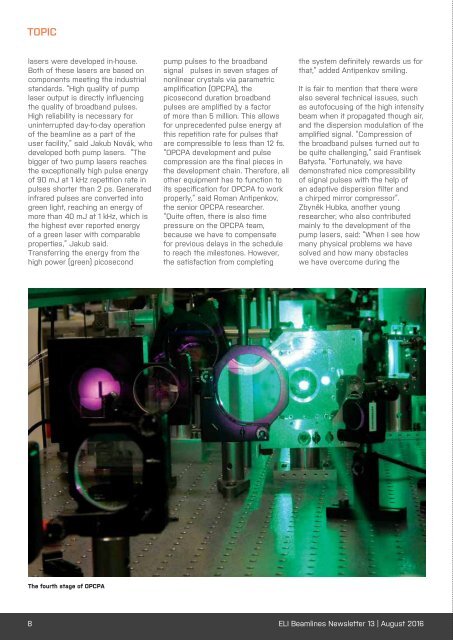No.13
Newsletter-13
Newsletter-13
You also want an ePaper? Increase the reach of your titles
YUMPU automatically turns print PDFs into web optimized ePapers that Google loves.
TOPIC<br />
lasers were developed in-house.<br />
Both of these lasers are based on<br />
components meeting the industrial<br />
standards. “High quality of pump<br />
laser output is directly influencing<br />
the quality of broadband pulses.<br />
High reliability is necessary for<br />
uninterrupted day-to-day operation<br />
of the beamline as a part of the<br />
user facility,” said Jakub Novák, who<br />
developed both pump lasers. “The<br />
bigger of two pump lasers reaches<br />
the exceptionally high pulse energy<br />
of 90 mJ at 1 kHz repetition rate in<br />
pulses shorter than 2 ps. Generated<br />
infrared pulses are converted into<br />
green light, reaching an energy of<br />
more than 40 mJ at 1 kHz, which is<br />
the highest ever reported energy<br />
of a green laser with comparable<br />
properties,” Jakub said.<br />
Transferring the energy from the<br />
high power (green) picosecond<br />
pump pulses to the broadband<br />
signal pulses in seven stages of<br />
nonlinear crystals via parametric<br />
amplification (OPCPA), the<br />
picosecond duration broadband<br />
pulses are amplified by a factor<br />
of more than 5 million. This allows<br />
for unprecedented pulse energy at<br />
this repetition rate for pulses that<br />
are compressible to less than 12 fs.<br />
“OPCPA development and pulse<br />
compression are the final pieces in<br />
the development chain. Therefore, all<br />
other equipment has to function to<br />
its specification for OPCPA to work<br />
properly,” said Roman Antipenkov,<br />
the senior OPCPA researcher.<br />
“Quite often, there is also time<br />
pressure on the OPCPA team,<br />
because we have to compensate<br />
for previous delays in the schedule<br />
to reach the milestones. However,<br />
the satisfaction from completing<br />
the system definitely rewards us for<br />
that,” added Antipenkov smiling.<br />
It is fair to mention that there were<br />
also several technical issues, such<br />
as autofocusing of the high intensity<br />
beam when it propagated though air,<br />
and the dispersion modulation of the<br />
amplified signal. “Compression of<br />
the broadband pulses turned out to<br />
be quite challenging,” said Frantisek<br />
Batysta. “Fortunately, we have<br />
demonstrated nice compressibility<br />
of signal pulses with the help of<br />
an adaptive dispersion filter and<br />
a chirped mirror compressor”.<br />
Zbyněk Hubka, another young<br />
researcher, who also contributed<br />
mainly to the development of the<br />
pump lasers, said: “When I see how<br />
many physical problems we have<br />
solved and how many obstacles<br />
we have overcome during the<br />
Pump beam to the third stage<br />
The fourth stage of OPCPA<br />
development of the front end<br />
together with the guys from the<br />
control team, I am really proud to be<br />
a part of this group.”<br />
A lot of work has also been done<br />
on integration of all the individual<br />
devices of the front end into one<br />
functional system. The timing<br />
system is responsible for sending<br />
trigger signals to optical switches,<br />
cameras, and shutters ensuring<br />
a precise synchronization of<br />
all events. Specially developed<br />
electronics and software are<br />
improving the stability of lasers by<br />
controlling active feedback loops.<br />
The machine safety system monitors<br />
all critical points of the laser and<br />
safely turns the system off when<br />
something unexpected happens.<br />
The control system then allows<br />
online control of integrated devices<br />
such as chillers, power supplies,<br />
and Pockels cells and gathers data<br />
from all other systems.<br />
“L1 laser team is thrilled to be<br />
working on such a unique laser<br />
system,” Bakule said. “Successful<br />
completion of the front end and<br />
booster system definitely proves<br />
the feasibility of the proposed<br />
design and gives us confidence<br />
that the completed system will be<br />
robust, stable and reliable and will<br />
be scalable to even higher energies<br />
in the case of future upgrades.” ■<br />
The laser team<br />
References:<br />
[1] “Thin disk amplifier-based 40 mJ,<br />
1 kHz, picosecond laser at 515 nm,”<br />
Opt. Express 24, 5728-5733 (2016)<br />
[2] “Broadband OPCPA System with<br />
11 mJ Output at 1 kHz, Compressible<br />
to 12 fs,” Opt. Express, doc. ID:<br />
264111 (posted 3. May 2016).<br />
8 ELI Beamlines Newsletter 13 | August 2016 9


